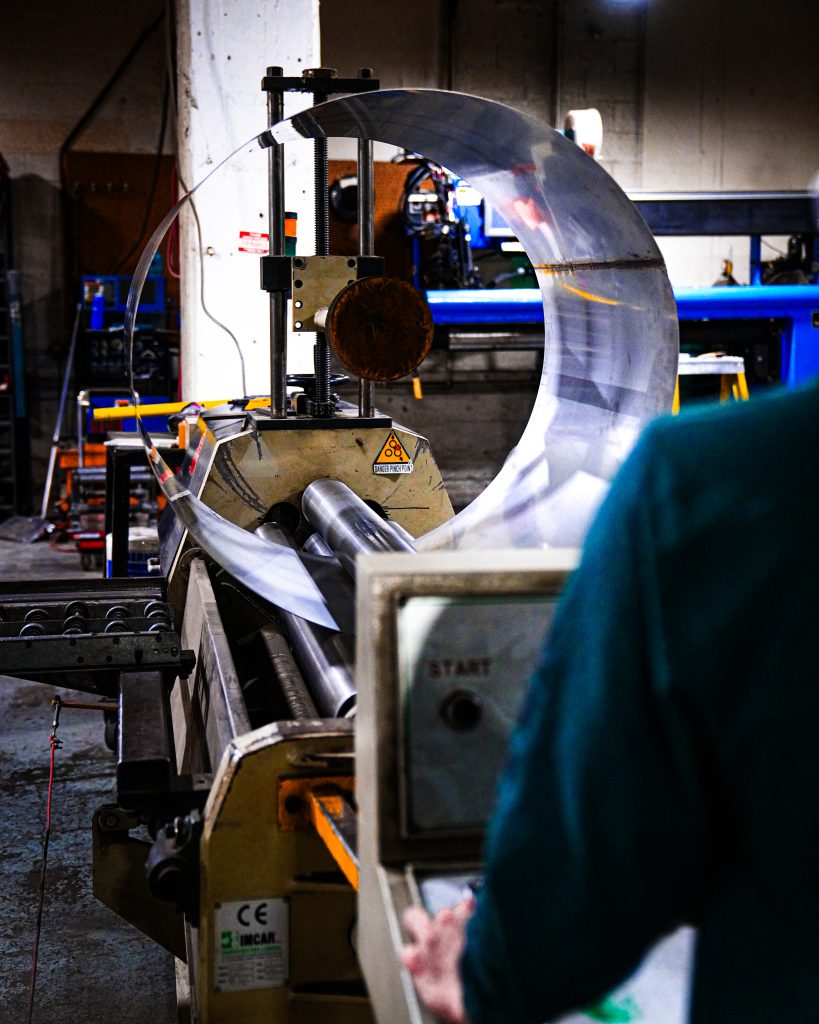Cylinders - The Forming Process
Custom cylinders are made through a process that begins by putting a flat sheet of material into the laser and programming it to cut rectangles out of various materials to specific sizes. If the cylinder has any customizations or features including custom holes, windows or other shapes, these are cut out in the laser, as well. The laser is able to cut through a variety of materials including steel, stainless steel, aluminum, copper, and other metals.
After the blanks are precisely cut, they are put through the rollers, where they are rolled into their required diameter. Prior to welding the seam, welds are tabbed, preventing ‘blow through’ on the cylinder’s ends, while ensuring a very strong and durable weld, fit for a lifetime of use. They are then sealed with a seam weld from the TIG automated welding system. After the weld is completed, it is planished, a process that ensures the weld is nearly flush with the cylinder, increasing its strength and durability yet again. Finally, the tabs are cut off, leaving smooth ends to the cylinder.
Once the forming process is complete, adding customizable features is an option, whether that be ribbed or custom formed ends, fittings, side holes, or flanges. Common configurations include no flanges, a single or double flange, custom cutout windows or doors, and custom steps and ribs.
What occurs during the forming process?
During the rolling process, rollers push the blank through at a specific angle based on the material type, thickness, blank size, and the required final cylinder diameter. As the material moves through the rollers, it undergoes permanent deformation without fracturing. The metal yields under pressure, allowing it to bend smoothly. Several factors influence the curvature, including roller diameter, feed speed, applied pressure, and material properties.
The rollers push the blank through at a specific angle, depending on the material type, thickness, size of the blank, and required final diameter of the cylinder. During the sheet rolling process, the material undergoes permanent changes without fracturing. As the sheet or blank moves through the rollers, the metal yields, which allows the bend. Factors including the diameter of the rollers, the speed that the sheet moves through, pressure applies, and the type and thickness of the material determine the curvature of the bend.
Steps in the Rolling Process
- Load assessment and force calibration
- The machine operator sets the bending force according to the material’s mechanical properties and the target cylinder radius. Proper calibration ensures precise deformation control during rolling.
- Blank positioning and alignment
- The sheet or blank is placed onto the roller table to ensure proper alignment and stability. Secure positioning minimizes material shifting, reducing the chance of distortion, and maintaining dimensional accuracy. Once in place, the rollers engage the blank, clamping it securely for controlled rolling.
- Pre-bending leading and/or trailing edges (method depends on machine type)
- Three-roll systems initiate bending at both ends before forming the full cylinder.
- Four-roll systems bend the leading edge first, then roll the central section, followed by the trailing edge.
- Incremental rolling process
- With the blank clamped and pre-bent, the sheet is progressively fed through the rollers under controlled pressure. The applied force induces plastic deformation, gradually shaping the blank into the required cylindrical form. The rollers exert uniform pressure along the sheet’s length, ensuring consistent curvature and maintaining material integrity. Multiple passes may be required to achieve the final geometry.
Four-Roller Machine Advantages
Four-roll systems feature a dedicated pinch roller that maintains constant material engagement, preventing slippage and improving precision. This design enhances rolling efficiency, especially for thinner or high-strength materials.
Advantages of Rolling
- Ability to form uniform, repeatable curves across a range of materials and thicknesses.
- Increased precision due to controlled deformation parameters.
- Compatibility with various material properties, including high-strength alloys.


Typical rolled and welded applications and products
Spools
Spools are used for connecting valves, tubes, or pipes to each other, using flanges equipped with bolt holes. Spools are extremely durable because of the extra support created by the flange. Spools can provide secure and leak-proof joints which allows for modification or eat access, that otherwise would not be possible.
Spray Dryers
Spray dryers are used to turn liquids into powders or granules in a single step. This is a common process in the food, pharmaceutical, and chemical industries because of its high efficiency, consistency, and adaptability.
HVAC
Typical HVAC equipment consists of cylinders with or without flanges. Fan blade and motor housings are a very popular use for these products. They allow for easy disassembly and reassembly, making it convenient for maintenance, repairs, or modifications.
Gravimetric Feeders
Also known as loss-in-weight feeders, gravimetric feeders are self-calibrating feeder systems that doses based on weight and speed. They offer precise flow control by automatically adjusting the material being dispensed, allowing the system to maintain a consistent feed rate. Volumetric feeders are similar, but dispense based on volume, rather than weight.